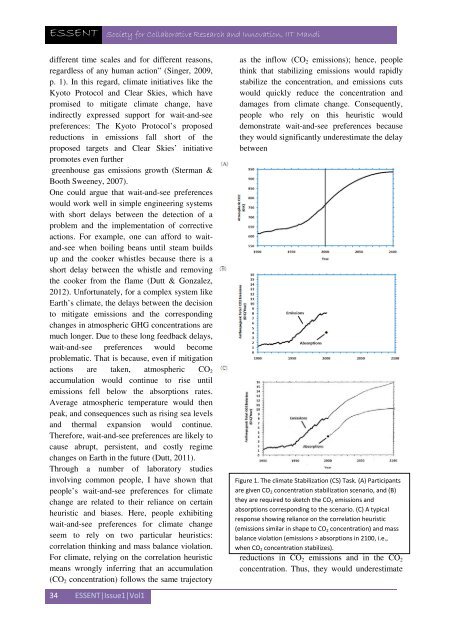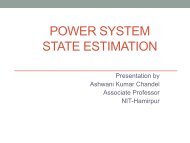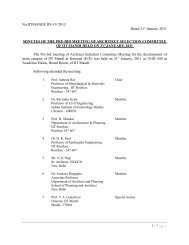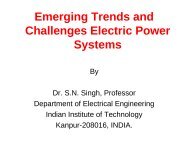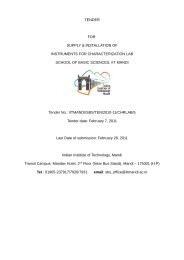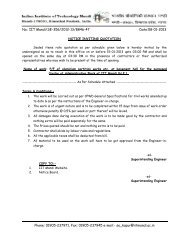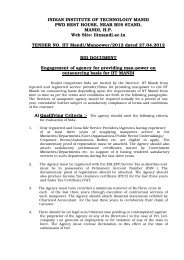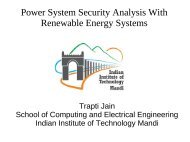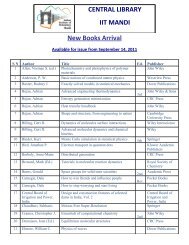Issue1. Vol.1 (April, 2013) - IIT Mandi
Issue1. Vol.1 (April, 2013) - IIT Mandi
Issue1. Vol.1 (April, 2013) - IIT Mandi
- No tags were found...
You also want an ePaper? Increase the reach of your titles
YUMPU automatically turns print PDFs into web optimized ePapers that Google loves.
ESSENT Society for Collaborative Research and Innovation, <strong>IIT</strong> <strong>Mandi</strong>different time scales and for different reasons,regardless of any human action” (Singer, 2009,p. 1). In this regard, climate initiatives like theKyoto Protocol and Clear Skies, which havepromised to mitigate climate change, haveindirectly expressed support for wait-and-seepreferences: The Kyoto Protocol’s proposedreductions in emissions fall short of theproposed targets and Clear Skies’ initiativepromotes even furthergreenhouse gas emissions growth (Sterman &Booth Sweeney, 2007).One could argue that wait-and-see preferenceswould work well in simple engineering systemswith short delays between the detection of aproblem and the implementation of correctiveactions. For example, one can afford to waitand-seewhen boiling beans until steam buildsup and the cooker whistles because there is ashort delay between the whistle and removingthe cooker from the flame (Dutt & Gonzalez,2012). Unfortunately, for a complex system likeEarth’s climate, the delays between the decisionto mitigate emissions and the correspondingchanges in atmospheric GHG concentrations aremuch longer. Due to these long feedback delays,wait-and-see preferences would becomeproblematic. That is because, even if mitigationactions are taken, atmospheric CO 2accumulation would continue to rise untilemissions fell below the absorptions rates.Average atmospheric temperature would thenpeak, and consequences such as rising sea levelsand thermal expansion would continue.Therefore, wait-and-see preferences are likely tocause abrupt, persistent, and costly regimechanges on Earth in the future (Dutt, 2011).Through a number of laboratory studiesinvolving common people, I have shown thatpeople’s wait-and-see preferences for climatechange are related to their reliance on certainheuristic and biases. Here, people exhibitingwait-and-see preferences for climate changeseem to rely on two particular heuristics:correlation thinking and mass balance violation.For climate, relying on the correlation heuristicmeans wrongly inferring that an accumulation(CO 2 concentration) follows the same trajectoryas the inflow (CO 2 emissions); hence, peoplethink that stabilizing emissions would rapidlystabilize the concentration, and emissions cutswould quickly reduce the concentration anddamages from climate change. Consequently,people who rely on this heuristic woulddemonstrate wait-and-see preferences becausethey would significantly underestimate the delaybetweenFigure 1. The climate Stabilization (CS) Task. (A) Participantsare given CO 2 concentration stabilization scenario, and (B)they are required to sketch the CO 2 emissions andabsorptions corresponding to the scenario. (C) A typicalresponse showing reliance on the correlation heuristic(emissions similar in shape to CO 2 concentration) and massbalance violation (emissions > absorptions in 2100, i.e.,when CO 2 concentration stabilizes).reductions in CO 2 emissions and in the CO 2concentration. Thus, they would underestimate34 ESSENT|Issue1|Vol1


